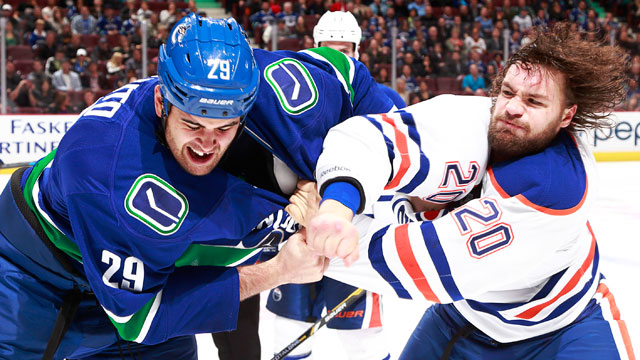Welcome to fighting’s finish line, a.k.a., Canadian Interuniversity Sports. It is here where the map on fisticuffs has been laid out for the National Hockey League to follow, where I predict it will get to one day. “Everybody thought it would hurt our game. It has not,” said University of Saskatchewan’s 21-year head coach, Dave Adolph. “Our league is a better place without fighting.”
I’ve always been pro-fighting. Or perhaps more aptly, against the pussification of hockey. I like hits and the odd scrap. I like hockey and I like rugby. I appreciate the beauty and skill of soccer, but am repelled by the drama queens who roll about the pitch with every bit of contact. I like a game it takes courage to play, and if both players are willing, a competitive hockey fight is absolutely fine with me.
Never again, however, do I need to see another Brian McGrattan-Tom Sestito or Stu Bickel-Michael Haley fight. Big palookas like Steve MacIntyre who can barely skate or play the game shouldn’t be skating and playing the game at a rink that charges admission to watch hockey. I have swayed on this point, yes.
I still believe, however, that Jarome Iginla or Andrew Ladd should be free drop their gloves and defend themselves. I’m fine with Derek Dorsett and Chris Neil, as long as they can skate well enough to dole out a few punishing bodychecks and be useful contributors with their gloves on-not just when they’re off
And I’ve certainly had enough of the lobby group calling for an all-out ban on fighting, or immediate suspensions for any hit to the head whether intentional or not. The faction that would bubble wrap every adult and child who pulls on a hockey sweater, and should perhaps choose a more genteel sport. As Bryan Marchment once said, “Go play tennis.”
Fighting is, in fact, not banned in CIS hockey. There are still a few scraps in the CIS-21 fighting majors recorded in 266 Ontario University Athletics conference games, plus playoffs last season-but, beginning in the mid-1980s and continuing today, it has been legislated out of the day-to-day. The sanctions simply make that violent release too costly. “We still felt last year that we had too many major penalties. So we increased the sanctions,” said Bryan Crawford, executive director of the OUA.
The rules are virtually unilateral through the Ontario, Atlantic and Canada West conferences. If you fight in a CIS game you receive a game misconduct and a one-game suspension-the equivalent of a red card in soccer. A second fight means a two-game suspension and a game misconduct; a third means a game misconduct, a minimum three-game suspension and a review by the league.
Interestingly however, if an instigator penalty is handed out in the OUA, the instigator receives the above treatment. The combatant deemed to have been forced into the fight receives only a five-minute major and nothing more. In Canada West, that non-instigator still gets kicked out of the game, but receives no further discipline.
So the CIS has successfully gone where the NHL will go one day as well. Fighting isn’t banned, but the goon is gone and suspensions have rendered fights to a pace of just two scraps through 53 Canada West games this fall. It should be noted that the feeling that there is more stick work under these fighting guidelines was unilateral among the people I spoke to this week. “I saw a huge difference coming from the Western Hockey League to the CIS,” said long-time Alberta Golden Bears coach Rob Daum, coaching now in Austria. “Little guys sticking players, things going on during scrums. There were things that happened that I know wouldn’t have happened (if fighting was more prevalent).”
Whether the NHL fan would trade heightened stick work for the virtual elimination of fighting, or whether the Patrick Kaletas and Daniel Carcillos would run wild in the new system is up for debate. Would we need three Brendan Shanahans to take care of whatever filled the fighting vacuum? Perhaps. This is the finish line, however. The place the NHL will end up at one day.
“The day they took fighting out, all us young (coaches) were totally petrified that-without the guy who could keep someone honest-it would all escalate. It has not,” said Adolph. “There’s a little more stick work, and a few more pretenders, but we don’t have the concussion (problems)… No one tries to hurt the skill guys. You almost stand out if you’re an idiot at our level.”
And the NHL could use fewer idiots.

